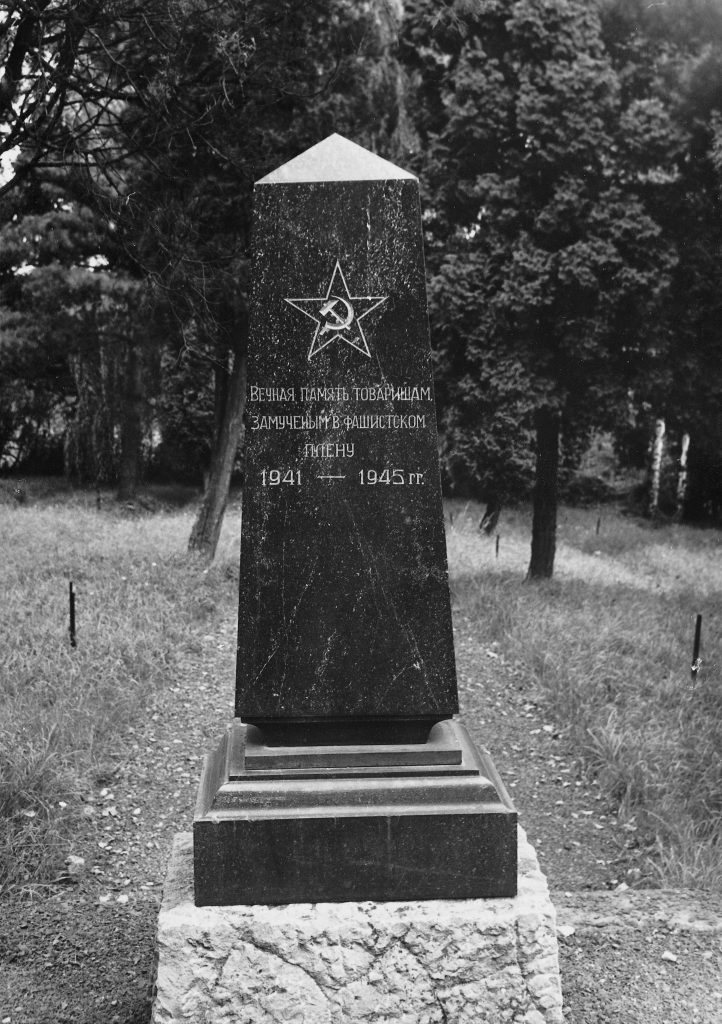Monuments of the prisoners cemetery
The path through the park-like grounds shows us various monuments of the POW cemetery. Taking the first steps across the prisoners’ cemetery, one notices relatively quickly the Celtic high cross that stands to the right of the path laid out of stone slabs.
A few steps further you come to a monument made of red sandstone, which, after a quick skim of the engraved text, you can easily recognize as a monument to the Russian prisoners of war.
If one knows that the cemetery is also called French cemetery in the language of the village Dietkirchen, one is surprised that there is no monument for the French fallen. In the following it is shown that there was also a French monument.
This page gives an overview of the technical data and the construction data of the monuments.
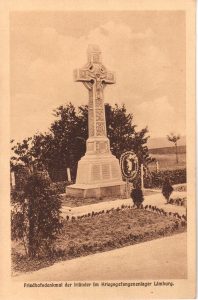
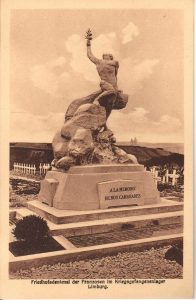
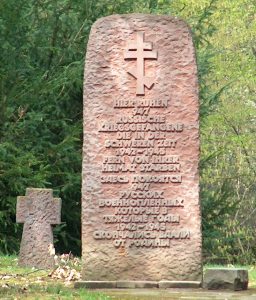
Irish prisoner of war memorial
The Irish prisoners of war from the World War I prison camp were the first to erect a memorial to their comrades who died in the camp.
The memorial was consecrated at Pentecost in 1917.
Dimensions:
Width: 1,60 m
Thickness: 0,50 m
Height: 3 m from the base of the cross
Material: sandstone
Architect: A. Meister from Bochum/Westphalia
Execution: Master stonemason Johann Klein from Münster/Westphalia
The school chronicle of Dietkirchen describes this monument very nicely.
At Whitsun of this year the cemetery of the local prison camp received a magnificent decoration. The Irish prisoners who were in the camp last year donated a wonderful monument in strictly Romanesque style in loving memory of their comrades buried there.
On a mighty base rises an enormous cross. From the base of the cross it measures 3 meters and is made of one piece. The width of the cross is 1.60 m, the thickness 0.50 m. It is made of sandstone.
In the center of the front you can see the image of the Crucified. At the top is the relief image of St. Patrik, the patron saint of Ireland. On the two arms of the cross there are two reliefs of saints. The image of the Savior has a powerful effect on the viewer.
On the back there are four Irish coats of arms: three crowns high above, the harp in the middle, the eagle with the sword on the left, an outstretched hand on the right.
All the images and reliefs are carved out of the stone.
On the back and the base are the 34 names of the Irish prisoners resting there.
An extremely symbolic relief is on the back of the lower part of the cross. The rising sun sends its rays, probably the hope of the Irish people. On a small chapel of the relief stands upright a small cross, indicating the help of God, a small falling cross symbolizes the deceptive hopes of this earth. The dog, as a symbol of vigilance, points to the future, the Irish people want to be vigilant, await the appropriate time of deliverance from long suffering.
The design of this work is by Mr. Architect A. Meister in Bochum i. The execution by Mr. Johann Klein, master stonemason from Münster i. W. The price is about 6000 M.
Original german text from the school chronicle
Zu Pfingsten d. Js. erhielt der Friedhof des hiesigen Gefangenenlagers einen herrlichen Schmuck. Die im vergangenen Jahre dahier im Lager befindlichen irischen Gefangenen haben in liebevollem Gedenken ihren dahier bestatteten Kameraden ein wunderbares in streng romanischem Stile ausgeführtes Denkmal gestiftet.
Auf mächtigem Unterbau erhebt sich ein gewaltiges Kreuz. Vom Kreuzsockel an mißt dieses 3 m und ist selbiges aus einem Stück gearbeitet. Die Breite des Kreuzes beträgt 1,60 m, die Stärke 0,50 m. Ausgeführt ist es in Sandstein.
In der Mitte der Vorderseite erblickt man das Bild des Gekreuzigten. Am oberen Ende ist das Reliefbild des hl. Patrik, des Schutzpatrons von Irland. An den beiden Kreuzesarmen sind noch zwei Reliefs von Heiligen. Auf den Beschauer wirkt mächtig das Bild des Heilandes.
Auf der Rückseite sieht man vier irische Wappen: hoch oben drei Kronen, in der Mitte die Harfe, links den Adler mit dem Schwert, rechts eine ausgestreckte Hand.
Sämtliche Bildwerke und Reliefs sind aus dem Steine herausgemeißelt.
Auf der Rückseite und dem Sockel stehen die 34 Namen der dahier ruhenden irischen Gefangenen.
Ein äußerst symbolisches Relief trägt auf der Rückseite der untere Teil des Kreuzes. Die aufgehende Sonne sendet ihre Strahlen, wohl die Hoffnung des irischen Volkes. An einer kleinen Kapelle des Reliefs steht aufrecht ein kleines Kreuz, hinweisend auf die Hilfe von Gott, ein kleines umfallendes Kreuz versinnbildet die trügerischen Hoffnungen dieser Erde. Der Hund, als Sinnbild der Wachsamkeit, zeigt auf die Zukunft, das irische Volk will wachsam sein, den geeigneten Zeitpunkt der Befreiung aus langem Leid erwarten.
Der Entwurf dieses Werkes ist von Herrn Architekt A. Meister in Bochum i. W. Die Ausführung von Herrn Steinmetzmeister Johann Klein aus Münster i. W. Der Preis beträgt ungefähr 6000 M.

French memorial
The French prisoners of war also erected a monument for their comrades who died in the camp.
Dimensions:
Width: estimated approx. 2.50 m
Depth: estimated approx. 1,50 m
Height: estimated approx. 3,00 m
Material: sandstone
Artist: Eduard Colomo (himself a prisoner in the camp)
This monument is also described in the school chronicle of Dietkirchen.
On August 3, 1918 the monument for the French prisoners of war who died in the local military hospital was solemnly inaugurated.
It was carved from Westphalian sandstone by French sculptors who were interned in the local camp. It is a naked male figure, standing on a high pedestal, looking upwards with his hand. It is generally regretted that the same does not correspond much to the Christian conception.
Original text from the Dietkirchen chronicle:
Am 3. August 1918 wurde das Denkmal für die im hiesigen Lazarett verstorbenen französischen Kriegsgefangenen feierlich eingeweiht.
Dasselbe wurde von französischen Bildhauern, die im hiesigen Lager interniert waren, aus westfälischem Sandstein gehauen. Es ist eine nackte männliche Figur, stehend auf hohem Sockel, welche Blick und Hand nach oben richtet. Allgemein bedauert man, daß selbiges der christlichen Auffassung wenig entspricht.
From the monument itself, at the close look over the cemetery and the knowledge about the monument, still a piece remained on the cemetery.
To the left above the grave of Captaine Hasne is the memorial plate that adorned the front center of the French memorial stone (see red mark on the postcard).
Also on the basis of this plate one can draw some conclusions about the presumed size of the memorial.
Dimensions of the plate:
- Width: approx. 1.10 m
- Height: about 0,55 m
- Material: sandstone
Unfortunately, so far no concrete information has been found as to when and why the French monument was dismantled and what, if anything, happened to the monument itself.
Was it smashed or was it moved in one piece to another place?
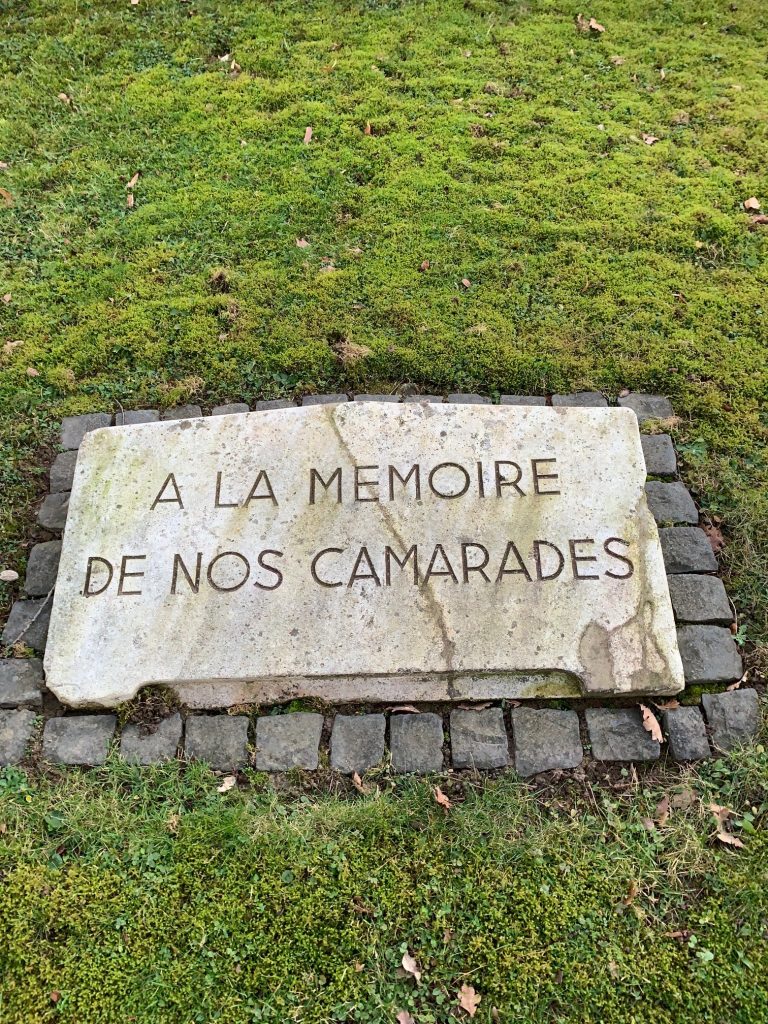
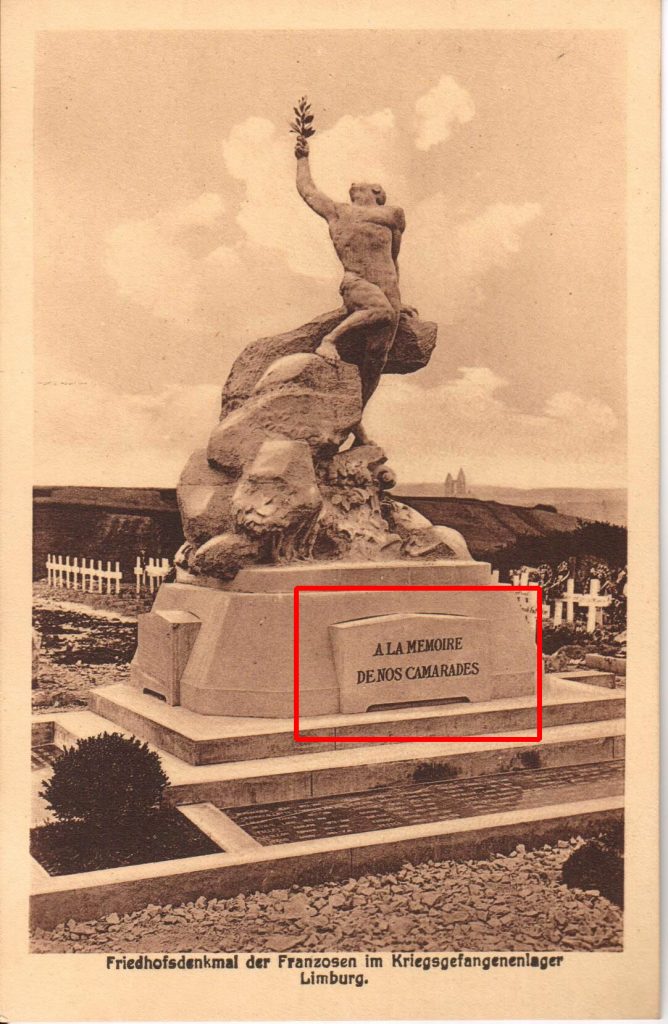

Russian prisoner of war memorial
The Russian war memorial is the youngest monument in the cemetery. According to unconfirmed sources it was erected in 1959 by the city of Limburg. Other sources state that it was erected by the Volksbund für Kriegsgräberfürsorge.
Dimensions:
Width: 0.85 m
Depth: 0,40 m
Height: 2,00 m
Material: red sandstone
Artist: unknown
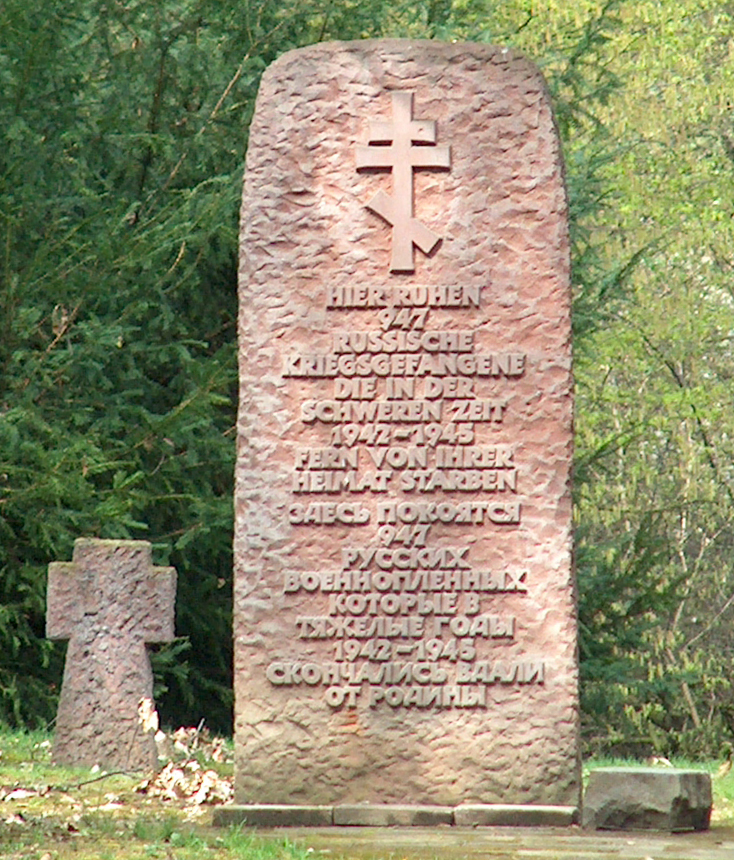
Predecessor monument to today’s Russian war memorial
A query to the Volksbund Deutsche Kriegsgräberfürsorge e.V. (German War Graves Commission) by the author did not yield any further clarification on the erection of today’s Russian war memorial.
However, the contact of 16.08.2021 provided the information that there had been a predecessor memorial.
Unfortunately, there is no information about this monument, when it was erected and by whom, and when and why it was dismantled and replaced by the present monument. Based on the inscription, however, it can be assumed that it was erected after the Second World War. So apparently there was no memorial for the Russian dead of World War 1.
According to the information from the German War Graves Commission (Volksbund Deutsche Kriegsgräberfürsorge e.V.), the picture was taken in 1959.
The inscription translates roughly as:
Eternal memory of those murdered by fascism
